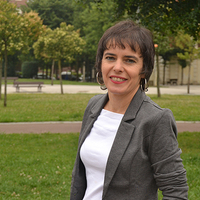Idoia Astigarraga
Mondragon Unibertsitatea, Audiovisual Communication, Faculty Member
Ikerketa honen helburua da ezagutzea zelan – eta zein neurritan- baliatzen dituzten gazteek digitalizazioak ekarritako ikus-entzunezko kontsumo-modu berriak, arreta berezia jarrita ikus-entzunezko edukien partekatzean. Doktorego-tesi hau... more
Ikerketa honen helburua da ezagutzea zelan – eta zein neurritan- baliatzen dituzten gazteek digitalizazioak ekarritako ikus-entzunezko kontsumo-modu berriak, arreta berezia jarrita ikus-entzunezko edukien partekatzean. Doktorego-tesi hau Mondragon Unibertsitateko kasu-azterketa da, eta galdetegia, egunerokoa eta sakoneko elkarrizketak baliatu dira. Galdetegiko emaitza kuantitatiboak dira artikulu honetan azalduko direnak. Emaitzek erakusten digutenez, ohiko telebistak jarraitzen du izaten telebistako edukiak kontsumitzeko biderik ohikoena. Bestalde, aipagarria da partekatzeak hartzen duen garrantzia, gazteen ia %68k partekatzen baititu ikus-entzunezko edukiak interneten.
Research Interests:
This article aims to analyze the audiovisual consumption patterns of 12 to 16 year-old adolescents, with particular emphasis on the television fiction contents. In order to understand the role of television series in the era of... more
This article aims to analyze the audiovisual consumption patterns of 12 to 16 year-old adolescents, with particular emphasis on the television fiction contents. In order to understand the role of television series in the era of audiovisual digitization, we have analyzed the preferences, motivations and practices of the adolescents. The study presents quantitative and qualitative data collected in 2011, two years after the digital switchover of television at the study area. This period is considered as the beginning of the digital era, and is characterized by new ways of audiovisual production, transmission and consumption, which have been considered. Questionnaires filled by 852 adolescents, as well as 26 interviews and 16 social network profiles, have been analyzed. The results showed that although consumption of fiction content is closely related to traditional television consumption practices, new expressions and experiences have arisen through the Internet.
Research Interests:
The Internet and ongoing innovations in media technology are having an impact on journalism and educators in mass communication. Many universities and journalism training schools are trying to adapt their curricula to the new landscape.... more
The Internet and ongoing innovations in media technology are having an impact on journalism and educators in mass communication. Many universities and journalism training schools are trying to adapt their curricula to the new landscape. Innovation and creativity are considered key concepts to deal with the new changing media environment, but, what does the official Spanish White Paper on Communication Degrees have to say about creativity and innovation? Do these concepts have any presence in the curricula for Spanish Communication Degrees? And, if so, how can this presence be fostered? After mentioning an interesting initiative involving Innovation Journalism at the Stanford Center for Innovation and Communication, this paper provides an outline of two interesting methodologies that can be used to promote both innovation and creativity in Communication Studies, namely Design Thinking and Creation Nets. Design Thinking refers to methods and processes for investigating defined problems, acquiring information, analyzing knowledge, and positing solutions/products in the design and planning fields (this particular style of creative thinking-in-action is having an increasing influence on twenty-first century education across disciplines). Creation Nets, on the other hand, have as their most distinctive value the ability to flexibly and scalably mobilize dispersed and diverse talent for innovation. This has been tested in the Innovation Incubator Project, a project developed via experimentation in seven journalism schools from the United States. The paper will go on to focus on an innovation project based on the Design Thinking process that is being developed on the Audiovisual Communication Degree at Mondragon University.
Research Interests:
Research Interests: Humanities and Art
Research Interests:
This article examines the relationship of university students with television and online video content. Convergence processes in many areas during the digital age have significantly changed both audiovisual content consumption patterns... more
This article examines the relationship of university students with television and online video content. Convergence processes in many areas during the digital age have significantly changed both audiovisual content consumption patterns and the content on offer itself. In addition, Web 2.0 has made it possible for interaction to go beyond mere consumption. The purpose of this research study was to ascertain what kind of interaction takes place between young people and audiovisual content. The categories analyzed are watch, share and create, with a focus on students' everyday life. A mixed-method approach was used across a sample of 475 students from Mondragon University. Our main finding is that, although young people have the resources necessary to interact with media, this condition is not sufficient to favor behaviors that are more active. Young people show different practices and attitudes depending on the individual, the content, and the context but, in general, the interact...
Research Interests:
This research analyzes the relationship of some university students with audiovisual content. Convergence processes in many areas during the digital age have changed significantly both audiovisual content consumption patterns and the... more
This research analyzes the relationship of some university students with audiovisual content. Convergence processes in many areas during the digital age have changed significantly both audiovisual content consumption patterns and the content on offer itself. In addition, Web 2.0 has made it possible for interaction to go beyond mere consumption. The purpose of this research is to ascertain what kind of interaction takes place between young people and audiovisual content. The categories analyzed are watch, share and create, with a focus on students’ everyday life. Furthermore, conventional television audiovisual consumption is compared with that carried out online, to find out whether there are different attitudes towards both platforms. Finally, young people’s reasons for interaction with and through content have also been studied. A mixed-method approach was used across a sample of 475 students from Mondragon University.
